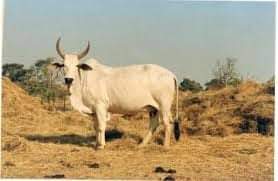History and Origin Of Malvi cattle breed
The Malvi cattle breed, originating from the Malwa region in India, is renowned for its resilience, strong working capabilities, and adaptability to harsh environmental conditions. This hardy breed has traditionally been used in farming and agricultural activities across central India, primarily in Madhya Pradesh, and is valued for both draught power and dairy purposes. Let’s delve into its characteristics, care requirements, and the business opportunities it presents.
Characteristics of Malvi Cattle
1. Physical Appearance:
Malvi cattle are medium-sized with a robust and muscular build, which contributes to their strength and endurance.
They have short, thick horns, a compact body, and a well-defined hump, which is typical of Indian zebu breeds.
Their coat color varies from white to light grey, and they have a distinctive blackish muzzle and eyes.
2. Hardiness:
These cattle are incredibly resilient, particularly suited to withstand the dry and semi-arid climates of central India.
They can tolerate significant temperature variations, which makes them ideal for regions with extreme weather conditions.
Malvi cattle are less susceptible to local diseases and can graze on low-quality feed, making them cost-effective for farmers.
3. Work Performance:
The breed is prized for its physical stamina and ability to perform heavy tasks like plowing and pulling carts, even in difficult terrains.
Male Malvi bulls are preferred as draught animals due to their endurance and strength.
4. Dairy Potential:
While Malvi cows are primarily used for draught power, they also produce milk. However, their milk yield is moderate compared to specialized dairy breeds.
On average, a Malvi cow produces between 500–700 liters of milk per lactation cycle.
The milk is rich in butterfat, which can be beneficial for dairy producers focusing on high-quality dairy products.
Business Opportunities in Malvi Cattle
1. Draught Animal Market:
There’s a strong demand for Malvi bulls in regions dependent on animal labor for agricultural work. For rural areas where mechanized farming isn’t accessible, Malvi bulls offer an economical solution.
Breeders focusing on selling young bulls for draught purposes can capitalize on this market, particularly in semi-urban and rural agricultural zones.
2. Dairy Production:
Although not primarily a dairy breed, Malvi cattle’s milk quality with high butterfat makes it suitable for niche dairy markets, such as ghee and other high-fat dairy products.
Entrepreneurs can establish local dairy farms focused on Malvi milk to cater to consumers looking for pure, organic, and traditional dairy products.
3. Cattle Breeding and Sales:
There’s a steady demand for Malvi breeding stock across India and internationally due to their adaptability and strength.
Maintaining a healthy and diverse breeding population can support the business of selling quality stock to farmers or organizations involved in livestock promotion.
4. Organic Fertilizer Production:
Malvi cattle manure is valuable for producing organic fertilizers, which are highly sought after in organic farming communities.
Farmers can establish a side business collecting, processing, and selling manure from Malvi cattle to nearby farms, especially those engaging in sustainable or organic agriculture.
5. Agri-Tourism and Cattle Shows:
Agri-tourism ventures that showcase traditional Indian cattle breeds can attract tourists interested in learning about indigenous breeds and their role in agriculture.
Participating in cattle shows, particularly in regions that celebrate indigenous breeds, can promote awareness about Malvi cattle, which could lead to breeding and sales opportunities.
Challenges in the Malvi Cattle Business
1. Limited Milk Production:
Since Malvi cows produce moderate quantities of milk, dairy business models focused on high milk yield may not find them profitable.
Entrepreneurs may need to market the milk as a premium product, focusing on quality over quantity.
2. Genetic Improvement Needs:
Genetic improvements are necessary to enhance productivity, and selective breeding is essential to preserve the breed’s hardiness while improving traits like milk yield.
Access to quality breeding bulls and semen for artificial insemination can sometimes be a challenge, which may require working with government or non-profit livestock development programs.
3. Awareness and Market Access:
Due to a lack of awareness, the full potential of the Malvi breed is not always recognized in markets outside central India.
Efforts to educate farmers and cattle entrepreneurs on the benefits of the Malvi breed and providing logistical support for transport and trade can improve profitability.
Best Practices for Running a Malvi Cattle Business
1. Proper Feed Management: While Malvi cattle can survive on low-quality feed, providing balanced nutrition improves their work stamina, health, and milk yield. Incorporate local feed resources like hay, dry fodder, and occasional supplementation of minerals.
2. Disease Prevention: Routine vaccination and preventive care are essential due to exposure to local diseases. Regular health check-ups and parasite control will ensure better productivity.
3. Selective Breeding Programs: Working with breeding experts to select bulls and cows with desirable traits can improve milk yield and work capacity, thereby enhancing the breed’s economic value.
4. Efficient Grazing Management: Since Malvi cattle are used to grazing, businesses should implement rotational grazing practices, which support sustainable land use and help cattle get the nutrition they need.
5. Marketing Initiatives: Effective marketing strategies such as branding Malvi milk and dairy products, promoting the unique qualities of Malvi bulls for draught, and participating in livestock fairs can expand market reach and increase revenue.
Conclusion
The Malvi cattle breed offers tremendous potential for businesses focused on traditional farming, draught animal power, and niche dairy products. Despite some challenges in milk production and limited awareness, the breed’s hardiness, adaptability, and versatility in agricultural settings make it valuable in India and beyond. Entrepreneurs interested in indigenous cattle breeds can find success by investing in proper breeding, marketing, and herd management. With growing awareness of organic farming and eco-friendly practices, Malvi cattle hold promise as a sustainable and profitable venture for the right business model.




